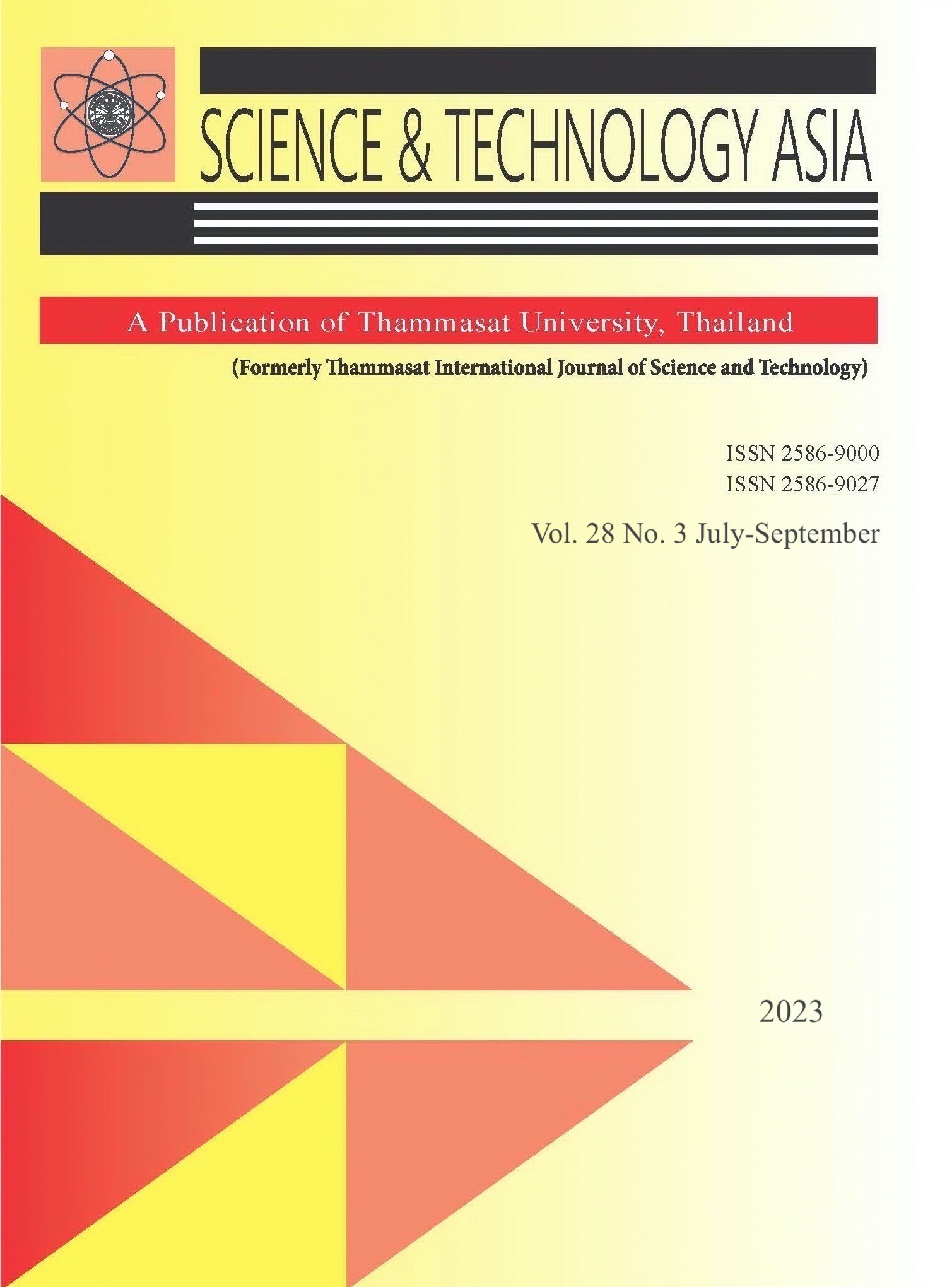Optimizing Extruded Snack Production from Germinated Med Fai Brown Rice by Using Response Surface Methodology
Main Article Content
Abstract
The aim of this study was to increase the value of Med Fai brown rice through germination and extrusion for production of healthy snacks. The physical and chemical properties of germinated Med Fai brown rice and the optimum extrusion conditions were determined. Med Fai paddy rice was germinated and prepared. The extruded Med Fai brown rice flour was produced using twinscrew extrusion cooking. The effects of process parameters such as germinated rice flour content (2.5-10%), screw speed (400-500 rpm) and die temperature (140-150°C) on extrudate properties were studied. Germination was found to have an influence on the physical and chemical properties of the germinated brown rice flour (GBRF). The Colour value (L* and b*), protein content, fiber content, -aminobutyric acid (GABA) content, vitamin B1 and total phenolic content were increased. The hardness, bulk density (BD) and colour values of the extrudates were all influenced by GBRF. Hardness and BD were increased when GBRF and die temperature were increased, but the expansion ratio (ER) and a* value were decreased. The ER and L* values decreased when the screw speed was reduced, but the a* value increased. 5.38% GBRF, 450.58 rpm screw speed and 144.55°C die temperature were the optimal extrusion parameters for germinated extruded snack. The extruded Thai curry-coated snack (Kang Kua) had the highest overall score of 7.67 (moderate to very good). Thus, the nutritional value of Med Fai brown rice flour was increased by germination. Extrusion conditions affected the properties of extruded Med Fai brown rice flour. Germinated Med Fai brown rice flour is suitable as a functional ingredient in snacks.
Article Details

This work is licensed under a Creative Commons Attribution-NonCommercial-NoDerivatives 4.0 International License.
References
na Sakon Nakhon, PP, Jangchud, K, Jangchud, A. and Charunch, C. Optimization of pumpkin and feed moisture content to produce healthy pumpkin-germinated brown rice extruded snacks. Agric Nat Resour. 2018;550-6.
Champagne, ET, Wood, DF, Juliano, BO. and Bechtel, DB. The rice grain and its gross composition. American Association of Cereal Chemistry, St. Paul, USA. 2004. p.77-107.
Posiri, D, Jumruskam, R, Plaiduang, S, Suwanno, S, Boonyanupong, U, Klinmanee, C, Thongdej, O, Sengsim, P, Kaewnango, E, Rattana, P, Wongpiyachon, S, Cheaupun, K, Sukviwat, W. and Wasusun, A. Med Fai 62, a non glutinous rice variety. Thai Rice Res J. 2020;44-57.
Ritruengdech, K., Kerdchoechuen, O., Laohakunjit, N., Chaiyakul, S. Effects of pregelatinization on physicchemical properties of flour of germinated brown rice cv. KDML 105. Agric Sci J. 2011;42(2)(Suppl):117-20.
Kayahara, H. and Tsukahara, K. Flavor, health and nutritional quality of pregerminated brown rice. Presented at 2000 Int Chem Congr Pac Basin Soc in Hawaii, December 2000.
Chanlat, N, Sonsermpong, S, Charunuch, C. and Naivikul, O. Twin screw extrusion of pre-germinated brown rice: physicochemical properties and gaminobutyric acid content (GABA) of extruded snacks. Int J Food Eng. 2011;1-15.
Chalermchaiwat, P, Jangchud, K, Jangchud, A, Charunuch, C. and Prinyawiwatkul, W. Antioxidant activity, free gamm,-aminobutyric acid content, selected physical properties and consumer acceptance of germinated brown rice extrudates as affected by extrusion process. LWT-Food Sci Technol. 2015;64: 490-6.
Kanojia, V. and Singh, M. Assessment of textural properties of brown rice based ready to eat extrudate snacks blended with water chestnut and safed musli powder. Indian J Sci Tecnol. 2016;1-7.
Chaiyasut, C, Sivamaruthi, S, Pengkumsri, N, Saelee, M, Kesika, P, Sirilun, S, Fukngoen, P, Jampatip, K, Khongtan, S. and Peerajan, S. Optimization of conditions to achieve high content of gamma amino butyric acid in germinated black rice, and changes in bioactivities. Food Sci. Rechnol. 2017;37(Suppl. 1):83-93.
Pardhi, SD, Singh, B, Nayik, GA. And Dar, BN. Evaluation of functional properties of extruded snacks developed from brown rice grits by using response surface methodology. J Saudi Soc Agric Sci. 2019;18: 7-16.
Koksel, F. and Masatcioglu, MT. Physical properties of puffed yellow pea snacks produced by nitrogen gas assisted extrusion cooking. LWT-Food Sci Technol. 2018;93.
Banchuen, J, Thammarutwasik, P, Ooraikul, B, Wuttijumnong, P. and Sirivongpaisal, P. Effect of germinating processes on bioactive component of Sangyod Muang Phatthalung rice. Thai J Agric Sci. 2009;42(4): 191-9.
Yanniotis, S, Petraki, A. and Soumpasi, E. Effect of pectin and wheat fibers on quality attributes of extruded cornstarch. J. Food Eng. 2007;80: 594-9.
Kanojia V. and Singh M. Extruded Product Quality Assessment Indices: A Review, Review article. Inter J Agric Sci, 2016; 8(54): 2928- 34.
Singh, S, Gamlath, S. and Wakeling, L. Nutritional Aspects of Food Extrusion: A Review. Int. J. Food Sci. Technol. 2007;42(8): 916-29.
Mercier, C. and Feillet, P. Modification of carboydrate components by extrusioncooking of cereal products. Cereal Chem. 1975;52: 283-97.
Soison, B, Jangchud, K, Jangchud, A, Harnsilawat, T, Piyachomkwan, K, Charunuch, C. and Prinyawiwatkul, W. Physico-functional and antioxidant properties of purple-flesh sweet potato flours as affected by extrusion and drumdrying treatments Int. J. Food Sci. Technol. 2014;49: 2067-75.
Singh, JP, Kaur, A, Shevkani, K. and Singh, N. Influence of jambolan (Syzygium cumini) and xanthan gum incorporation on the physicochemical, antioxidant and sensory properties of glutenfree eggless rice muffins. Int J Food Sci Technol. 2015;50:1190-7.
Fletcher, SI, Richmond, P. and Smith, A.C. An experimental study of twin screw extrusion cooking of maize grits. J Food Eng. 1985;4(4): 291-312.


